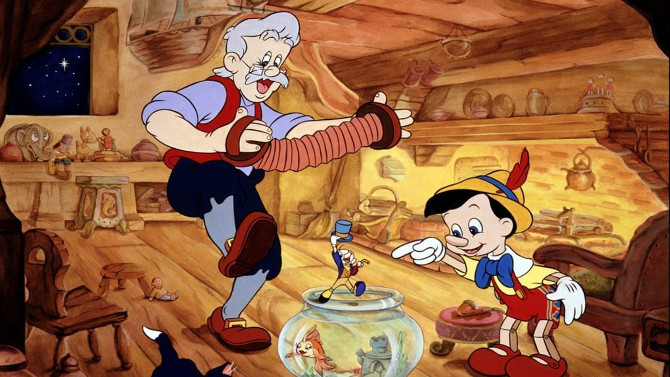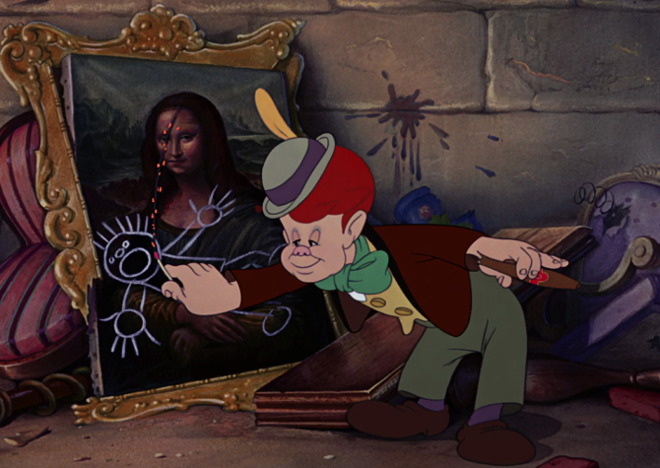Only the second feature film to be made by Disney (the first was Snow White and the Seven Dwarfs), Pinocchio, released in 1940, was, shockingly, a failure at the box office (partially due to distribution problems relating to World War II). . . though, after many re-releases, including the highly successful 1945 venture, it flourished.
A complex and influential undertaking, it took five sequence directors (Norman Ferguson, T. Lee, Wilfred Jackson, Jack Kinney, and Bill Roberts), two supervising directors (Hamilton Luske and Ben Sharpsteen), and a mind-boggling seven writers (Ted Sears, Otto Englander, Webb Smith, William Cottrell, Joseph Sabo, Erdman Penner, and Aurelius Battaglia), as well as uncredited scribe Bill Peet to bring Carlo Lorenzini’s (better known by nom de plume Carlo Collodi) fairy tale, “The Adventures of Pinocchio”, to life.
Narrated by Jiminy Cricket (Cliff Edwards), a vagabond tramp wandering the world, the insect is drawn into a home by the warm light seeping out of a window late one night. The residence/shop of an elderly toy and clockmaker named Geppetto (Christian Rub), the man has spent each and every day building intricate mechanisms for others, bringing joy into their lives, never making time for himself – his biggest regret, never having a son of his very own.
Surrounded by his prancing cat, named Figaro (spoiled and often jealous, the feline definitely has some attitude – Figaro was Walt Disney’s favourite character, pushing for the cat to get as much screen time as possible), and graceful goldfish Cleo (she has a flirtatious side), Geppetto has finally completed one of his most elaborate works, a marionette that he has coined Pinocchio (Dickie Jones). Going to sleep after finishing the job, from his bed he spots a wishing star, and utters the words, “star light, star bright, first star I see tonight. I wish I may, I wish I might, have the wish I make tonight”.
Wishing for little Pinocchio to become a real boy, a Blue Fairy (Evelyn Venable) descends from the heavens, breathing life into the wooden figurine, and also gives Jiminy Cricket (who has finally piped up after spending most of his time in the shadows) a fashion makeover, turning him into Pinocchio’s conscience. Pinocchio is told that if he proves himself ‘brave, truthful, and unselfish’, someday he will become a real boy. And, let us not forget how she adds to his burden by making sure that his nose grows every time he tells a lie.
Challenged on his very first day, Pinocchio is very much a morality tale, symbolic of every young boy or girls’ evolution in life. Met with difficult decisions, it is quite clear that the triumvirate of virtuous goals mentioned above is what the filmmakers intend to highlight as its key lesson.
Sidelined by ‘Honest’ John Worthington Foulfellow the Fox (Walter Catlett) and his mute accomplice, Gideon the Cat (originally to be voiced by icon Mel Blanc, they decided to go with a character that would be silent instead – all that is left of Blanc’s performance are the few hiccups heard from his mouth); ‘Honest’ John is anything but, a sly devil in worn though fashionable garb, who is aided by his rather dim-witted sidekick. It is a cleverly formed duo, resembling a more sinister version of a Marx Brothers or Laurel and Hardy skit.
Looking to make a quick buck, they trick the wooden boy into becoming an actor. . . selling him to Stromboli (Charles Judels), a larger than life, greedy puppet master who sees dollar signs when he looks at Pinocchio. Not only tempted by fame, the living puppet will soon be tested by the opportunity to vandalise, gamble, smoke and drink, among other things. He will have to find his way through these deceptive obstacles, with the help of trusty Jiminy Cricket by his side.
Impressive in its darkness, Pinocchio is a fascinating tale for both adults and children. Its villains are some of the most oppressive found in early Disney features – deceptive and greedy. Pinocchio’s time spent on Pleasure Island is a perfect example of this. A shady facade, those who indulge in the many unscrupulous activities find themselves transformed into donkeys (Lampwick, the memorable buck-toothed character, voiced by Frankie Darro, is one such example), to be sold off for profit by those running the seedy carnival. Highlighting the often bestial nature of drugs, alcohol and gambling, it is another challenge everyone will meet as they grow up – having to find a safe and happy medium. Also, subtle sexual jokes are littered throughout, for instance, when Jiminy rests his hand on a female statuette’s derrière, or when he takes out opera-like glasses to watch the sultry Can-Can girls at the puppet show. Likewise, there are lines of dialogue that are surely directed at adults rather than children. . . my favourite: “well. . . guess he won’t need me anymore. What does an actor want with a conscience, anyway?”. The climactic sequence in some ways relates to the Biblical story of Jonah and the Whale. . . though they have different happenings along the way, both are about redemption.
A costly expenditure, it did not help that over 2,300 feet of animation was destroyed by Disney – over five months of work, as the man was unimpressed with the characterization and look of Pinocchio, who was originally much less likeable and far less cute. When things did get on track, all of the main characters were built as three dimensional clay models (known as maquettes) – detailed guides for the animators (with many of the actors as stand ins for their personas. . . not only was Evelyn Venable the stand in for The Blue Fairy, but also for the original iteration of the Columbia Studios’ logo). Important items like the fancy clocks and creative toys were also built to aid their animators. To take it a step further (much like with Snow White), live action scenes were shot with all of the actors performing pantomime – a prime guide for how the body moves and how angles look onscreen. The creative team also utilized rotoscope, a way in which individual frames of filmed live action are used to create cartoons (one such example is Stromboli’s wagon), this, along with many other techniques utilized during filming, providing a dynamic experience which made headway in the ways in which water, weather, vehicles and other such things would be animated in the future. On the acting front, the voice performers spent nineteen months recording dialogue and songs for the production, while Leigh Harline and Ned Washington wrote the memorable songs, and Paul J. Smith scored the film. Though all of this may sound rather dry and theoretical, it is these complex techniques that give Pinocchio its lasting warmth and humanity, be it the richly drawn characters or the picturesque European locales, the eerie underwater sequences or the inside of a gargantuan whale, and, of course, the magical voices, songs and music.
Just as important today as it was when it was released, Pinocchio is a spectacle of magical proportion. Beautifully constructed, richly imaginative, and heart-warmingly told, it is the type of tale that ensnares the senses; its care, colour and message the stuff that can draw in children and cynical adults alike. So, please revisit this golden Disney classic, I wouldn’t be lying if I told you that you will have a whale of a time.


